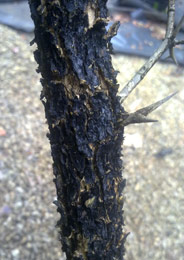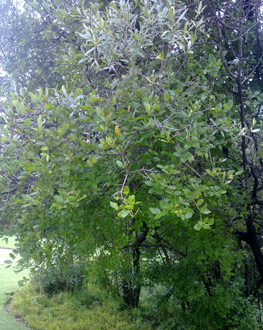Carissa edulis
Carissa edulis Vahl
Family: Apocynaceae
Common names: simple-spined num-num, climbing num-num, small num-num, (Eng.); enkeldoringnoemnoem, ranknoemnoem, kleinnoemnoem (Afr.); mothokolo (North Sotho); murungulu (Venda), umlugulu (Ndebele), murambara, muraramombe, muruguru, mutsamviringwa, nzambara, esamviringa, umsamviringwa (Shona), morogola (Lovedu)
SA Tree No: 640.4
Introduction
A fast-growing, thorny, scrambling shrub with glossy foliage, masses of fragrant white flowers in spring and small, oval red edible fruits in summer.

Description
Description
Carissa edulis is a much branched spiny evergreen shrub or small tree, usually multistemmed, often scrambling up to 6 m tall and forming a dense canopy. All parts of the plant release white, non-toxic, milky latex.

Young branches are green, smoothly covered with short hair, but older branches and stem become light brown and corky with deep cracks. The plant is armed with rigid spines up to 70 mm long and nearly always simple, not forked as with other species.

Leaves are simple and opposite, leathery, dark green above and paler below, with or without hair; and leaf base is shallowly lobed; margins are smooth; leaf stalk up to 5 mm long.

Flowers in terminal heads up to 40 mm in diameter, white tinged pink to purple and up to 20 mm long; corolla with lobes overlapping to the right, with a strong sweet jasmine-like scent. Flowering in spring and early summer, from September to December.

Fruits fleshy, ovoid, 6-11 mm in diameter, red to purplish black berries 2- to 4-seeded. Unripe fruits are green with red to purplish marks. Ripe fruits are dark red to purplish black.
Conservation Status
Status
This species is Least Concern (LC), not at risk of extinction (Raimondo et al. 2009). It does not qualify for any of the categories of threat.

Distribution and habitat
Distribution description
It occurs in bushveld, often in riverine vegetation or on termite mounds,and common in deciduous to evergreen woodland; it is partial to granite soil.
The distribution is from Senegal and East Africa in the north to Mpumalanga and Limpopo in the south. Also in Asia to India and Thailand, and on some Indian Ocean islands.
Derivation of name and historical aspects
History
The genus name Carissa is derived from the Indian name for plants of this genus, which contain a bitter and poisonous glucoside in the bark called carrisin. The species name edulis means 'edible', referring to the fruits.
Other species of Carissa include C. macrocarpa, C. bispinosa and C. tetramera.
Ecology
Ecology
Leaves are browsed by kudu, nyala, bushbuck, impala and grey duiker and the fruit eaten by kudu, grey duiker, baboons , monkeys and bush pigs. Birds favour the tree for nest building, and fruit eating birds (francolins, louries, hornbills, barbets and bulbuls) love the fruits.
It is also an ideal refuge for small animals and reptiles like snakes.
Uses
Use
Traditionally decoctions of roots are used as pain killer and to treat malaria. Taken warm and in small quantity it is also used for indigestion and for abnormal pains during pregnancy. The fruits help in the treatment of dysentery. The powdered root is used as a remedy for chest complaints. An infusion made from the roots is drunk to ease stomach ache, as a cough remedy or is dropped into the eye for cataract problems. Roots contain carissin that can be used to treat cancer. It has been successful in treating Herpes simplex virus.
Fruits are edible, the milky red pulp having a pleasant sweet taste and being much sought after. The fruit can be fermented to make a refreshing pink wine or left longer to make vinegar. Boys eat the fruits when looking after livestock in the forest.
If planted close together it can be grown as an effective hedge to keep intruders out and can take heavy pruning quite well. When planted as a hedge along a fence after a period of eight years the hedge will be so thick that no stock or game will be able to penetrate it. A delightful addition to any garden, it does not have an invasive root system and can be planted close to buildings. It makes a successful background plant with its scrambling habit and masses of fragrant whitish flowers.
Growing Carissa edulis
Grow
It can be propagated from both seeds and cuttings. Fill a tray with river sand and place the seeds on the surface, press them into the sand until they are flush with the surface and cover with a layer of sand equal to the thickness of the seed.
Keep them in a warm spot; germination takes about 7-14 days. Seedlings can be transplanted into nursery bags filled with a mixture of soil and compost (2:1 ratio) when they reach the 2-leaf stage, or they can be planted into open ground. Seedlings and young plants are frost-tender and should be covered by grass or shade cloth for the first two winters if grown in an area affected by frost. The simple-spined num-num has a growth rate of 1-2 m per year; it is very drought resistant.
References
- Najma Dharani. 2002. Field guide to common trees and shrubs of East Africa . Struik, Cape Town.
- Van Wyk, Braam [A.E.] & Van Wyk, P..1997. Field guide to trees of southern Africa. Struik, Cape Town.
- Van Wyk, Braam [A.E.] & Van Wyk, P.. 2007. How to identity trees in southern Africa . Struik, Cape Town.
- Venter, S. & Venter, J. 2007. Making the most of indigenous trees . Briza Publications, Pretoria.
- Raimondo, D., Von Staden, L., Foden, W., Victor, J.E., Helme, N.A., Turner, R.C., Kamundi, D.A. & Manyama, P.A. (eds) 2009. Red List of South African plants 2009 . Strelitzia 25. South African National Biodiversity Institute, Pretoria.
Credits
Thompson Mutshinyalo and Refilwe Malatji
Walter Sisulu National Botanical Garden
June 2012
Plant Attributes:
Plant Type: Scrambler, Shrub, Tree
SA Distribution: Limpopo, Mpumalanga
Soil type: Sandy, Loam
Flowering season: Spring, Early Summer
PH: Acid, Alkaline, Neutral
Flower colour: White, Pink
Aspect: Full Sun
Gardening skill: Average
Special Features:
Horticultural zones








Rate this article
Article well written and informative
Rate this plant
Is this an interesting plant?
Login to add your Comment
Back to topNot registered yet? Click here to register.